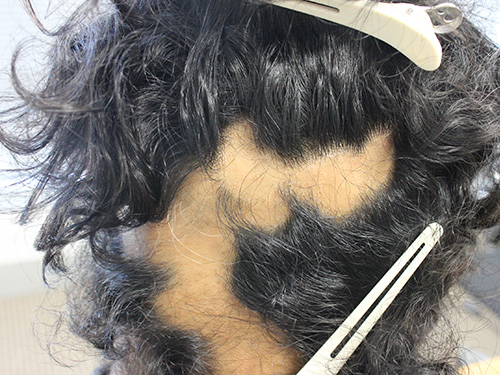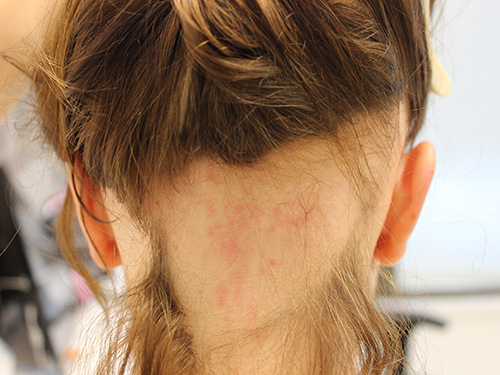Introduction to alopecia areata
Alopecia areata is a complex polygenic autoimmune disorder. Unknown environmental triggers signal an auto-inflammatory immune response that causes anagen phase hairs in the affected area to convert to telogen phase. Hair prematurely stops growing and sheds rapidly, causing patches of alopecia.
Alopecia areata produces discrete, often circular, areas of hair loss anywhere on the body. Patients are more likely to present when hair loss is on the scalp, eyebrows or beard. See here for photos of alopecia areata on the scalp. Hair loss that involves the entire scalp is called alopecia totalis. Hair loss that involves the entire scalp and whole body is called alopecia universalis.


Alopecia areata is characterised by unpredictable remission and relapse. A patch may:
- regrow hair spontaneously
- stay the same for many months
- enlarge and coalesce with other patches.
If a patient presents with a single patch of hair loss, the chance of spontaneous complete regrowth within 12 months is up to 80%; however, many patients relapse. Poor prognostic indicators for alopecia areata include:
- onset in childhood
- extensive disease at initial presentation
- ophiasis pattern (ie band-like alopecia involving the posterior scalp margin)
- family history of alopecia areata or a predisposition to autoimmune conditions
- history of atopy
- nail changes (eg pits, roughening).
The aim of treatment is to prevent the patch of hair loss from expanding and to stimulate regrowth within it. Treatment is not always warranted if the patch is no longer active and regrowth is visible. The choice of treatment depends on the extent and duration of hair loss; long-standing extensive involvement is usually resistant to most forms of treatment. See treatment options for alopecia areata with limited hair loss of recent onset or alopecia areata with extensive hair loss.
Alopecia areata has significant psychosocial consequences in both adults and children. Hair loss is distressing and often signifies a loss of personal identity, which is under-recognised by many treating health professionals. Provide emotional and social support to the patient and their family when waiting for hair to regrow, and also if hair does not regrow. Always ask the patient about mood changes, and refer them to a psychologist if needed. The Australia Alopecia Areata Foundation (AAAF) provides resources and support for people with alopecia areata and their families.
